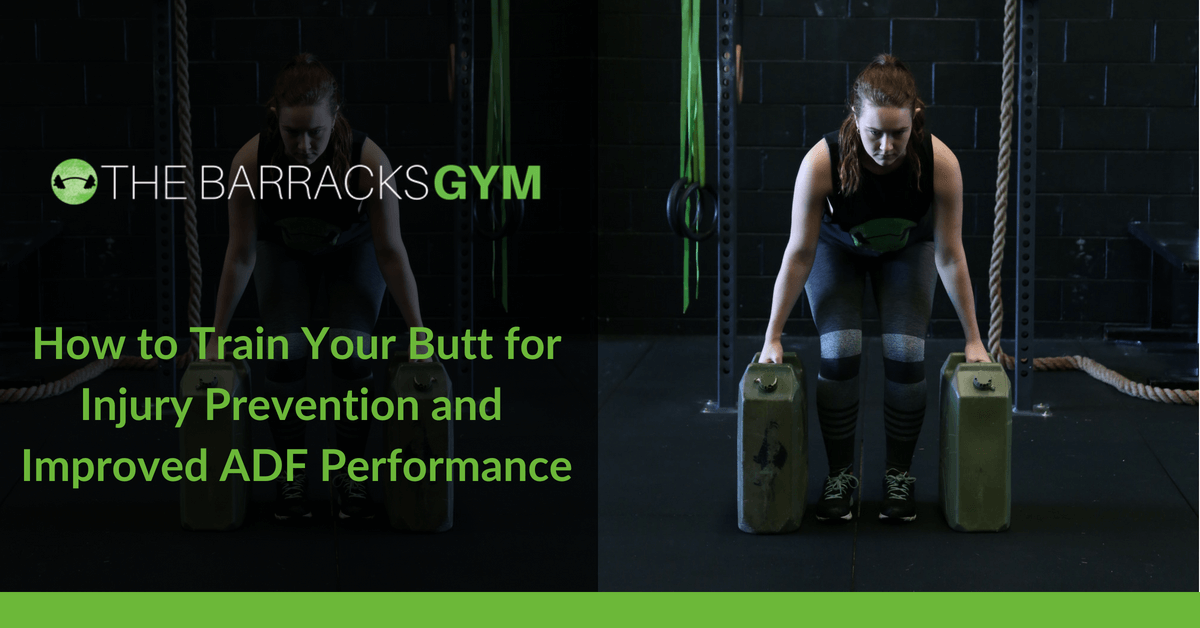|
When training for your ADF entry fitness test, it can be tempting to focus purely on the exercises assessed. In reality, though, you’d be far better suited to focusing on overall fitness, endurance and strength with special attention to your posterior chain. The posterior chain is, in brief all the muscles that make up the "back" side of our body. It includes the muscles along your spine, rear deltoids, glutes and hamstrings among others. While each muscle group is significant for their own reasons, developing strong glutes (butt) is crucial to improving your overall performance and preventing a whole host of injuries. Here’s all you need to know about this crucial group of muscles and how you can train them in an efficient manner ahead of your Australian Defence Force PFA. What Are The Glutes? The glutes are the three muscles that make up your buttocks.
Why Focus On The Glutes? Even from the very brief understanding of the glutes above, you can understand that the glutes are essential for your body’s overall performance. Cardiovascular and strength-related movements are both influenced heavily by the glutes. The glutes aren’t only the biggest muscles in the body; they are among the strongest muscles too. However, they are usually left dormant and underused, which can limit their power and potential. Only a suitable level of attention and work can prevent this from becoming an ongoing problem. Even if we ignore the impact stronger glute muscles can have on your speed and power in the beep test or in aiding your push-ups, understanding the risk of injuries a weak or dormant butt can trigger is important. Just to name a few: Back Pain: Weak glutes, particularly the gluteus medius, can lead to the onset of chronic lower back pain. An anterior pelvic tilt is encouraged by the inadequate extension into the terminal range, resulting in ongoing dull pains. Hamstring Strains: The hamstring muscles can become overused through hip extensions and explosive movements due to a delayed response from the gluteus maximus. Without the right attention, repeat injuries are likely to occur too. Hip Pain: When the gluteus maximus endures reduced power throughout the hip extension, it will lead to wear and tear as well an increased femoral anterior glide. Over time, this can result in chronic pains and restricted movements. Knee Pain: Without the desired level of glute strength, the damage caused to the hip and femur will bring knee pains. When coupled with the lack of stabilising qualities offered directly to the knee, weak glutes may also encourage collapses. Ankle Pain: The knee problems which stem from weak glutes will naturally put the quads, calves, and other leg muscles under immense strain. As they try to compensate for those issues, this can put the ankles at risk of collapsing too. IT Band Syndrome: IT band syndrome is brought on by weak hip abductions, which are associated with weak gluteus maximus muscles. This is because the gluteus maximus has an insertion into the fascia lata. Calf/Achilles Pain: Due to the lack of workload being completed by the glutes, virtually all leg muscles have to work. The added strain will cause problems in the calf and Achilles areas of the leg. The pains are worsened by the other problems mentioned above. Aside from preventing injuries, training the glutes provides the explosive power and stabilising balance needed to complete many of the ADF test challenges. How To Train The GlutesThe glutes are a large, complex, and commonly underused muscle group. However, The Barracks Gym can actively support the development of stronger glutes to bolster your performance levels and reduce the threat of injuries in one fell swoop. Some of the critical areas of exercise include;
Add these accessory moves to your main strength sessions and notice the difference in a few weeks. Wrapping UpThe glutes are among the most significant muscle groups in the body. Many of the ADF job roles will require you to be fast, agile, great at carrying weight in a variety of situations and be able to change position and move quickly when needed. If you want to prevent injuries and ensure you are in top shape, work on that posterior chain! Not only your back, but your butt and hamstrings.
Need help making sure you are conducting the correct training? Check out your training options here.
0 Comments
Leave a Reply. |
Most PopularTrusted PartnerWe work with the best service provider for Defence and First Responders.

Get SocialCategoriesArchives
January 2024
|
© COPYRIGHT 2024. ALL RIGHTS RESERVED.


 RSS Feed
RSS Feed